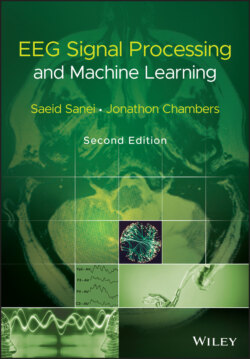Читать книгу EEG Signal Processing and Machine Learning - Saeid Sanei - Страница 17
1.5 EEG Generation
ОглавлениеAn EEG signal is an indirect measurement of currents that flow during synaptic excitations of the dendrites of many pyramidal neurons in the cerebral cortex. When the brain cells (neurons) are activated, the synaptic currents are produced and propagate through the dendrites. This current generates a magnetic field measurable by EMG machines and a secondary electrical field over the scalp measurable by EEG systems.
Figure 1.6 Structure of a neuron.
Figure 1.7 The head layers from brain to scalp.
Differences of electrical potentials are caused by summed post‐synaptic graded potentials from pyramidal cells that create electrical dipoles between the soma (body of a neuron) and apical dendrites which branch from neurons (Figure 1.6). The current in the brain is generated mostly due to pumping the positive ions of sodium, Na+, potassium, K+, calcium, or Ca++, and the negative ion of Cl−, through the neuron membranes in the direction governed by the membrane potential [24].
The human head consists of three main layers of scalp, skull, brain (Figure 1.7) including many other thin layers in‐between. In addition, the scalp consists of different layers such as skin, connective tissue, which is a thin layer of fat and fibrous tissue lying beneath the skin, the loose areolar connective tissue, and the pericranium, which is the periosteum of the skull bones and provides nutrition to bone and capacity for repair. Conversely, the brain is covered by a thin layer of cortex, which encompasses various brain tissues. The cortex includes arachnoid, meninges, dura, epidural, and subarachnoid space. The skull attenuates the signals approximately one hundred times more than the soft tissue. Conversely, most of the noise is generated either within the brain (internal noise) or over the scalp (system noise or external noise). Therefore, only large populations of active neurons can generate enough potential to be recordable using the scalp electrodes. These signals are later amplified greatly for display purposes. Approximately 1011 neurons are developed at birth when the CNS becomes complete and functional [25]. This makes an average of 104 neurons per cubic millimetre. Neurons are interconnected into neural nets through synapses. Adults have approximately 5.1014 synapses. The number of synapses per neuron increases with age, whereas the number of neurons decreases with age.
Given the diversity in electric and dielectric properties of the head layers, the distribution of attenuation of brain discharges including cortical, subcortical, and hippocampal activities is not uniform over the scalp and is subject to nonlinearity. Therefore, to model the neuronal pathways or localization of brain activity sources an accurate head electrical model should be available.
From an anatomical point of view the brain may be divided into three parts: the cerebrum, cerebellum, and brain stem (Figure 1.8). The cerebrum consists of both left and right lobes of the brain with highly convoluted surface layers called the cerebral cortex.
The cerebrum includes the regions for movement initiation, conscious awareness of sensation, complex analysis, and expression of emotions and behaviour. The cerebellum coordinates voluntary movements of muscles and balance maintaining.
The brain stem controls involuntary functions such as respiration, heart regulation, biorhythms, neurohormones, and hormone secretion [26].
The study of EEG paves the way for diagnosis of many neurological disorders and other abnormalities in the human body. The acquired EEG signals from a human (and also from animals) may for example be used for investigation of the following clinical problems [26, 27]:
Monitoring alertness, coma, and brain death.
Locating areas of damage following head injury, stroke, and tumour.
Testing afferent pathways (by EPs).
Monitoring cognitive engagement (alpha rhythm).
Producing biofeedback situations.
Controlling anaesthesia depth (servo anaesthesia).
Investigating epilepsy and locating seizure origin.
Testing epilepsy drug effects.
Assisting in experimental cortical excision of epileptic focus.
Monitoring the brain development.
Testing drugs for convulsive effects.
Investigating sleep disorders and physiology.
Investigating mental disorders. Figure 1.8 Diagrammatic representation of the major parts of the brain.
Recognition of emotions for autistics.
Monitoring mental fatigue for pilots and drivers.
Providing a hybrid data recording system together with other imaging modalities.
This list confirms the rich potential for EEG analysis and motivates the need for advanced signal processing techniques to aid the clinician in their interpretation. We next proceed to describe the brain rhythms, which are expected to be measured within EEG signals.
Some of the mechanisms that generate the EEG signals are known at the cellular level and rest on a balance of excitatory and inhibitory interactions within and between populations of neurons. Although it is well established that the EEG (or MEG) signals result mainly from extracellular current flow, associated with summed post‐synaptic potentials in synchronously activated and vertically oriented neurons, the exact neurophysiological mechanisms resulting in such synchronization to a given frequency band, remain obscure.
